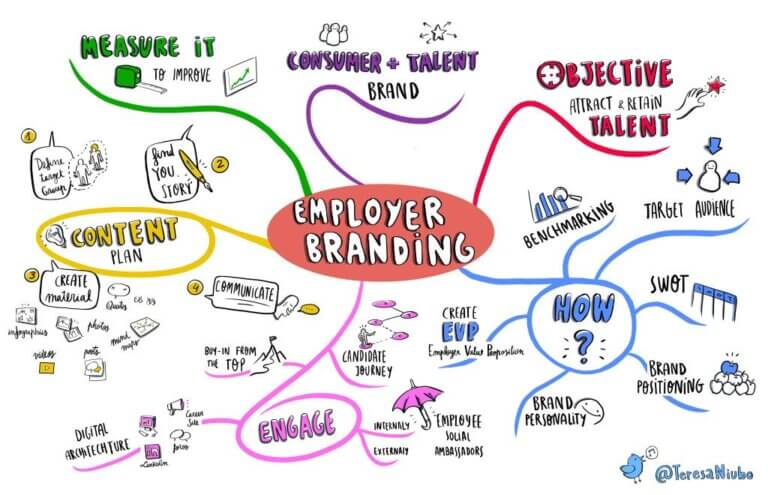Attract and retain great employees with these 7 steps for implementing your employer value proposition.
Your startup’s reputation as an employer is a key indicator of your hiring success. With 83% of recruiters admitting we are in a candidate-driven employment market, startups must strategically use their Employer Value Proposition (EVP) to stand out among the competition.
Now that your EVP is solidified—if you haven’t yet done this, go back and read this—it is time to spread the word.
Follow these 7 steps to implement and best utilize your employer branding:
1. Update your career page.
Think of your career page as the overarching driver of your employer branding. This is where potential candidates should find the most information about your culture and employer core values. By implementing your (now perfected) messaging accompanied by enticing visuals, you’ll provide the best point of reference for current and potential candidates.
This page should not appeal to everyone—only your ideal candidate. Get creative with the various mediums you include and keep the “sales funnel” of the candidate in mind. Only once they read and feel aligned with your core values should they be prompted with current openings. Continue the funnel as you guide potential candidates to explore your social channels, team page and recent blogs.
Still don’t have an Employer Value Proposition (EVP) for your startup? Click below and download your free guide to discovering, creating and implanting strong employer branding for faster, better hiring.
2. Ensure employee alignment.
While good copy and supporting visuals can help drive home your employer brand messaging, your employees will always be your most valuable asset. Take the time to internally review your updated EVP to ensure your current employees have a full understanding, as they will be the mouthpiece for potential referrals and on employee-driven platforms such as Glassdoor.
Encourage your current employees to update their professional social profiles to accurately reflect their current position at your company (including active links to the correct company profile on that site and job description). This will give potential employees a more complete picture of your brand, reinforced by the happy employees who are currently work at your company, and proudly display this badge on their social profiles.
3. Refresh talent-facing digital media.
With the majority of candidate research happening through social channels, it is vital that your EVP messaging remains consistent across all platforms. Sites relevant to startup recruitment include: Glassdoor, LinkedIn, Indeed and AngelList. Each of these platforms offer a customizable company profile page which can be created or claimed and populated with content. Before claiming and updating these pages, find out if anyone else in the company is currently using them. If so, work with them to build out a strategy to update the page, and manage the delivery of your messaging.
Social media recruiting can help an employer get to know potential job candidates and learn if they will fit in well with your team. Using social media takes recruiting back to the basics of searching for candidates: networking. Once these go-to sites have been updated to adequately reflect the employer brand you are trying to promote, you may want to consider investing in additional steps to further optimize your online presence to help build your talent pipeline and engage those interested in working with you.
4. Build out content within brand pillars.
Now that your social media platforms are branded to reflect your new and improved EVP, you’ll need to remain active on the appropriate channels. Optimal EVPs have three to five core values or brand pillars; use these to build out your supporting content for your internal newsletter or messaging, blog and social media content.
For example, if one of your core values is “Be the change,” build out content that highlights employees embodying that core value within their work or otherwise. That could mean showcasing an employee’s fundraising efforts for a particular nonprofit they are interested in or recognizing a new process developed by an employee that will change and improve how your team does their work.
5. Actively humanize your company as an employer.
Use social media to share your workplace culture. Keep your informal social media accounts populated with behind-the-scenes images and videos to show off your company’s culture and values.
For example, share photos of team members’ home offices, feature employees on their birthday or give a sneak peek of the team’s latest project. This will give prospective candidates an inside look into what they could be a part of.
Another way you can humanize your employer brand is by giving back to the community. Providing the opportunity for employees to get involved in their community reinforces your authenticity, increases trust and demonstrates that you actually care about the community you operate in. Employees are able to form a deeper connection to the place they work, and derive a sense of fulfilment from exercises like these where they can see they are making a difference. Community involvement also provides leadership opportunities for employees, which results in increased staff involvement and productivity.
Consider providing employees with a set afternoon off for volunteering at a local foodbank; picking up trash; or if you’re a marketing firm, volunteer by giving a local charity’s website a quick update on the house. It’s a small sacrifice that provides a significant reward for which your customers and potential candidates will recognize your good deeds.
6. Address the important questions before they are asked.
Although they may differ from industry to industry, there are a few topics that are always of importance to potential candidates including: remote work, diversity and work-life balance.
Be transparent about remote working versus office working.
By ensuring candidates understand your company’s stance on remote work, you will attract talent that thrive in your organization’s work environment. When promoting remote opportunities, address the three main concerns of remote workers: loneliness, communication and work-life balance. Your employer brand messaging should highlight the solutions to these common concerns.
For example, providing details on the communication tools available within your organization along with tangible benefits to help support mental wellbeing can help ease top candidate concerns. If talent believes your company is only half-heartedly committed to remote work, they will gravitate towards the many other employers who already adopted remote-first security in their messaging. If you do not see remote work being a viable option for your company in a post-pandemic world, address the expected office life with transparency.
Celebrate diversity.
Cultivating a diverse workplace is not just a compliance-related goal, it is also a clear competitive advantage. Diverse companies are 1.7 times more likely to be innovation leaders in their market segments, according to Recruitee. By conducting a diversity hiring audit, removing bias language from branding and showcasing current diversity, the barriers that stand in between your startup and incredibly talented candidates will begin to breakdown.
Efforts such as posting on a variety of job boards and encouraging referrals can make a huge impact to the volume and quality of inbound applicants to your organization. Remember this is an ongoing effort that should be reevaluated by outside resources.
Promote work-life balance.
Whether your startup has opted for remote working, office working or a hybrid, work-life balance has never been more important. Candidates are looking for employers who care about their wellbeing inside and outside of the workplace. Speak to any tangible benefits or programs your company is implementing. This could be anything from a weekly team yoga session to a monthly wellness budget.
7. Listen, evaluate and tweak if necessary.
Now that your EVP has been implemented across all platforms, it is time to listen to how it is being received by your ideal candidate. As mentioned, your employer branding will not and should not be attractive for everyone. Your startup’s specific brand pillars and core values should speak to the ideal candidate that will succeed in your company. That being said, it’s important that you listen to those individuals to ensure that the messaging was clear and cultural expectations understood. This is not a step that you can necessarily check off your to-do list, but an ongoing process.
____________________________________________________________________________________________________________________
It’s no surprise that candidates hold the power. Where once one’s job market was limited to the opportunities available in their own cities, candidates now can apply to a plethora of options from around the globe. With an employer pool not constrained by location, top talent is only applying to the most promising workplaces—by following these seven steps for implementing your EVP across your employer branding your startup can be one of those places.
For a full rundown of how to discover, create and implement your Employer Value Proposition (EVP), download your free digital copy of The Ultimate Guide for Startup Employer Branding.








